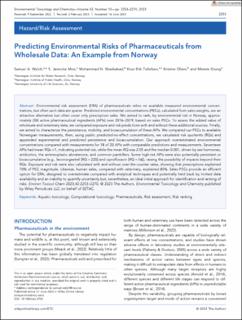| dc.description.abstract | Environmental risk assessment (ERA) of pharmaceuticals relies on available measured environmental concentrations, but often such data are sparse. Predicted environmental concentrations (PECs), calculated from sales weights, are an attractive alternative but often cover only prescription sales. We aimed to rank, by environmental risk in Norway, approximately 200 active pharmaceutical ingredients (APIs) over 2016–2019, based on sales PECs. To assess the added value of wholesale and veterinary data, we compared exposure and risk predictions with and without these additional sources. Finally, we aimed to characterize the persistence, mobility, and bioaccumulation of these APIs. We compared our PECs to available Norwegian measurements, then, using public predicted-no-effect concentrations, we calculated risk quotients (RQs) and appended experimental and predicted persistence and bioaccumulation. Our approach overestimated environmental concentrations compared with measurements for 18 of 20 APIs with comparable predictions and measurements. Seventeen APIs had mean RQs >1, indicating potential risk, while the mean RQ was 2.05 and the median 0.001, driven by sex hormones, antibiotics, the antineoplastic abiraterone, and common painkillers. Some high-risk APIs were also potentially persistent or bioaccumulative (e.g., levonorgestrel [RQ = 220] and ciprofloxacin [RQ = 56]), raising the possibility of impacts beyond their RQs. Exposure and risk were also calculated with and without over-the-counter sales, showing that prescriptions explained 70% of PEC magnitude. Likewise, human sales, compared with veterinary, explained 85%. Sales PECs provide an efficient option for ERA, designed to overestimate compared with analytical techniques and potentially held back by limited data availability and an inability to quantify uncertainty but, nevertheless, an ideal initial approach for identification and ranking of risks. | en_US |

